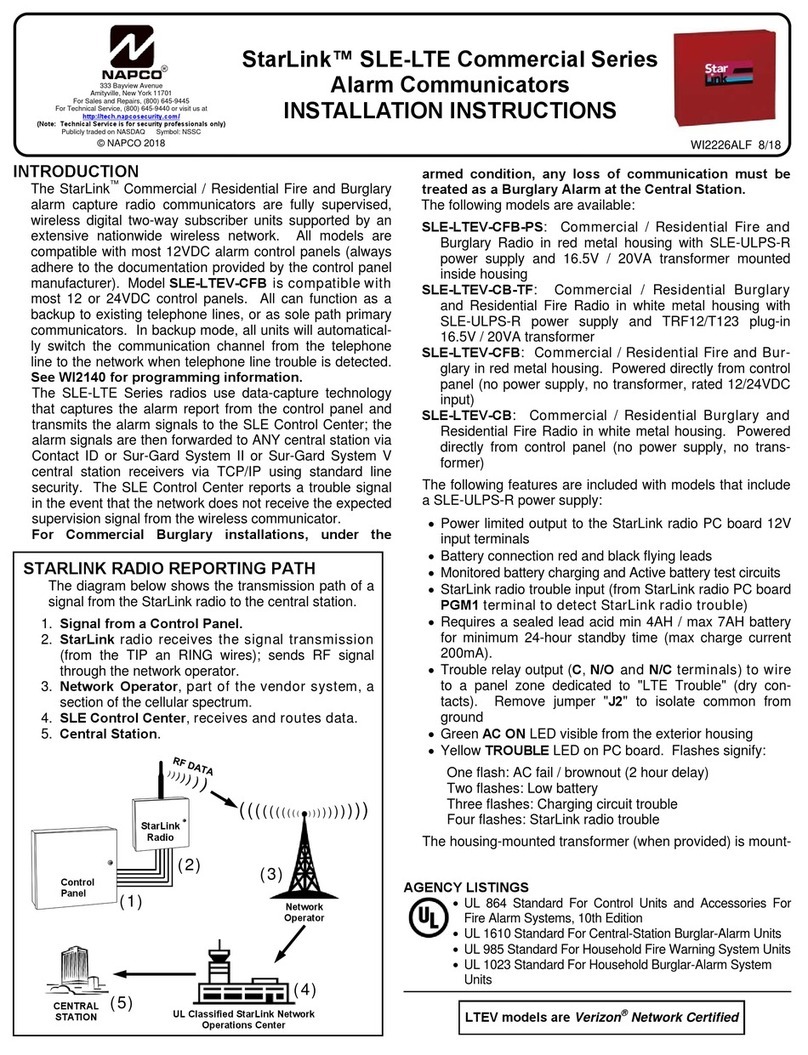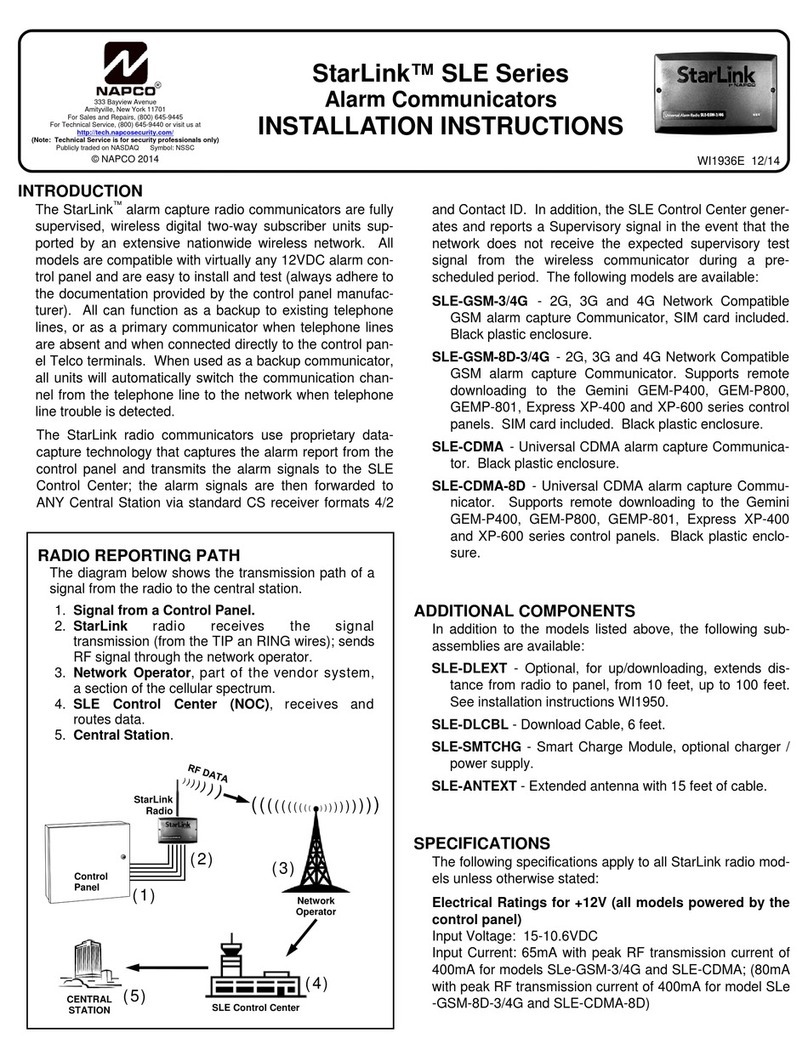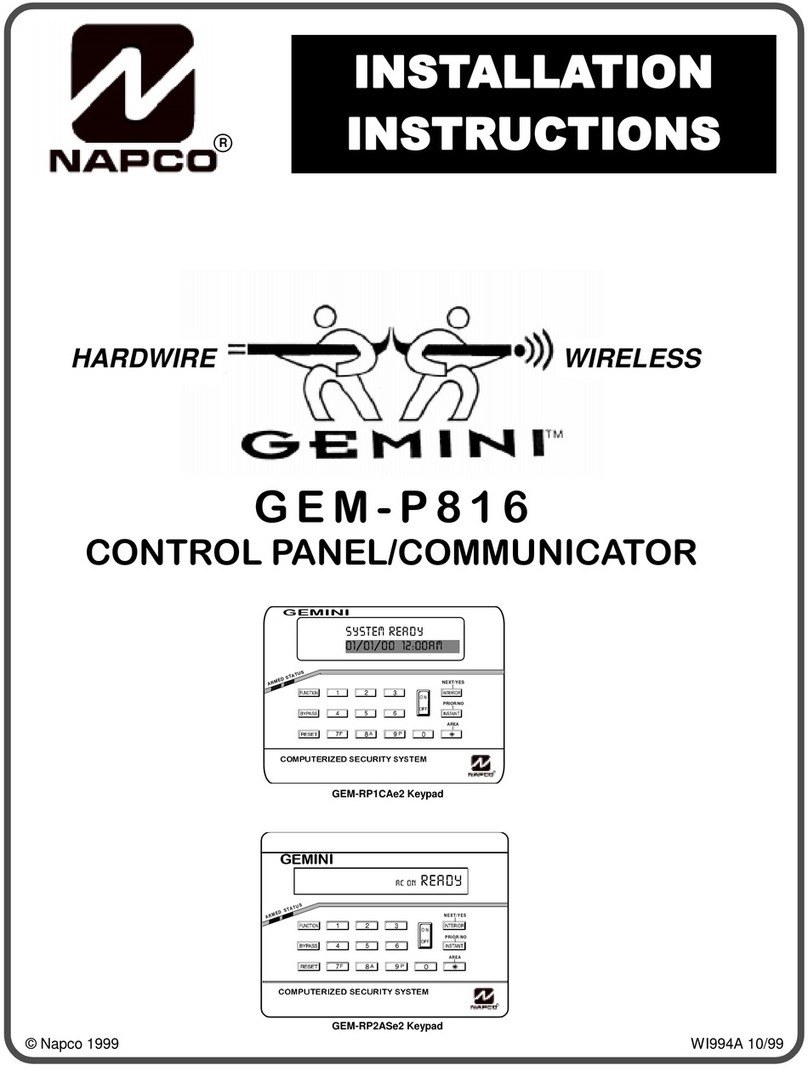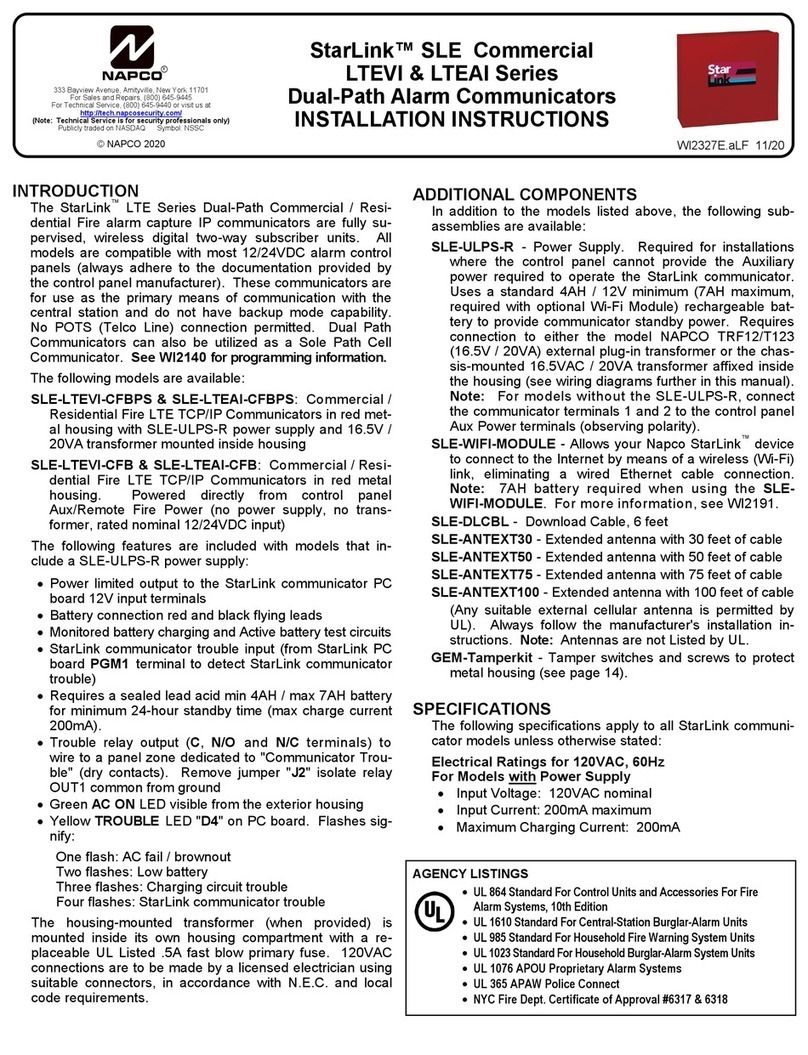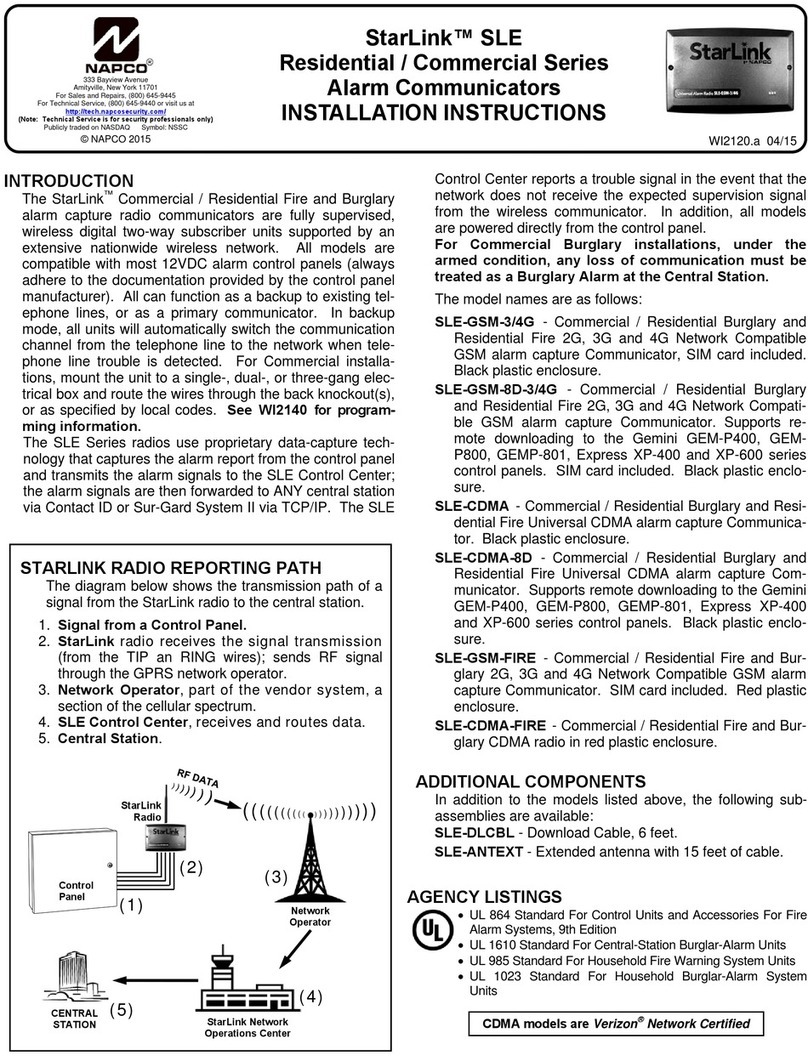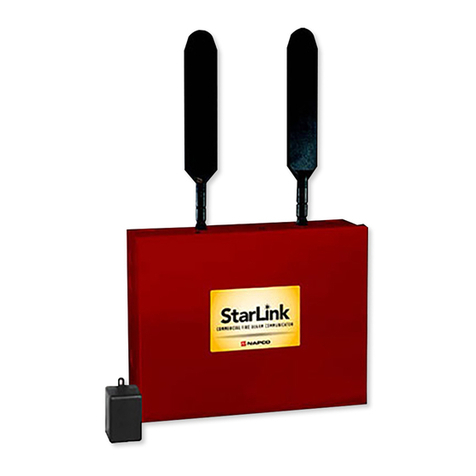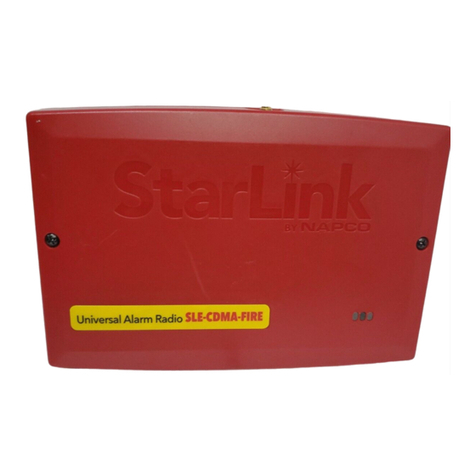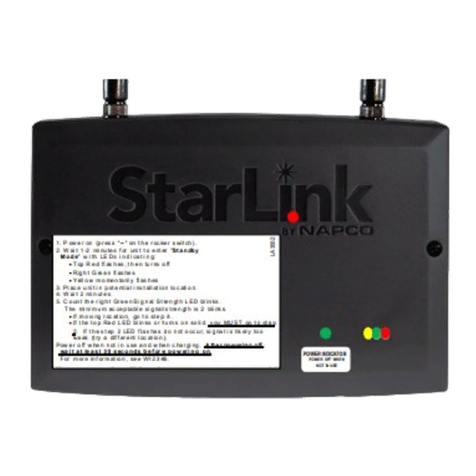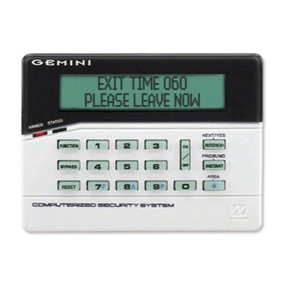
StarLink™SLE Commercial LTEVI & LTEAI Series Dual-Path Alarm Communicators -- Installation Instructions 5
(Place JP1 shunt on bottom two pins)
Wiring Methods
Strip wire carefully to avoid exposed conductors after
installation, etc.
Use UL Listed wire, ensuring that all conductors are to
be insulated for the maximum voltage of any conductor
in the enclosure
All wiring methods must be performed in accordance
with NFPA 70, Articles 725, and 800
STEP 4: APPLY POWER
Attach antennas before applying power !
Apply 12/24VDC to terminals 1 and 2. (For models
without the charger board SLE-ULPS-R). For models
with the SLE-ULPS-R, apply power to the unit.
STEP 5: SIGNAL VERIFICATION
Verify Online: To verify that the signals have been
received by the StarLink radio Network online, go to
www.NapcoNOC.com, log in with your Username and
Password, enter your Company ID number and the
StarLink Radio Number, then click Signal Log.
IMPORTANT: Verify that the signals transmitted by the
StarLink radio have been properly received by your central
station before leaving the premises.
NAPCO GEMINI C-SERIES (GEMC)
CONTROL PANEL PROGRAMMING
To program the central station receiver reporting format,
use PCD-Windows Quickloader download software. Open
the Digital Communications screen, Central Station Re-
ceivers tab, as shown in the following image:
A "Point ID" (also called "Contact ID") receiver format pro-
gramming example is shown:
The radio can transmit to any central station capable of
receiving SIA Contact ID or 4/2 via DACR technology or
the DSC Sur-Gard Model System II or Sur-Gard System V
central station receivers, Bosch D6100IPV6 or Bosch
D6600 Receiver (with ITS-D6686 Ethernet Adapter) via
TCP/IP using standard line security.
Note: A receiver reporting format must be entered for
each telephone number used, but each telephone number
may be assigned a different format.
Note: UL Listed for UL 1076 APOU Proprietary Alarm
Systems and UL 365 APAW Police Connect when report-
ing to a UL Listed Central Station Receiver Listed for UL
1076 APOU Proprietary Alarm Systems or UL 365 APAW
Police Connect, respectively. For TCP/IP only Bosch
D6600 or D6100IPV6 for UL1076 and UL365 applications.
CAUTION: The installer should always be certain an
area code is programmed into the control panel.
Optional: If you wish the StarLink radio to report a code
and zone number (Contact ID by default) to the central sta-
ules registered via the Internet are enabled for activation
within 24 hours.
STEP 2: SELECT A MOUNTING LOCATION
The mounting location should be indoors within the protect-
ed area and selected based on RF performance. It is
HIGHLY recommended that the installer carefully adhere to
the following recommendations BEFORE any wires are
installed.
Generally, high locations are best. DO NOT mount ra-
dio in basements or below grade as unpredictable per-
formance may result.
DO NOT mount the radio in non-climate controlled envi-
ronments (i.e. attics may become extremely hot in sum-
mer, garages may become extremely cold in winter).
Avoid mounting locations within 3 feet of AC power
lines, fluorescent light fixtures, or large metal objects (air
conditioners, metal garage doors, etc.) as these loca-
tions have been shown to have a detrimental effect on
signal strength.
A fair amount of care may be required to mount the
StarLink radio so as to achieve an optimal RF path. The
installer should spend as much time as needed to obtain
the highest signal level possible.
a. Before applying power, be sure to connect the
antenna. Temporarily connect power to the
StarLink radio from a fully charged 12V (4AH mini-
mum) battery. DO NOT mount the radio at this
time. Press Tamper switch to send a signal.
b. Position the unit in the desired mounting location,
with antenna oriented vertically. The signal strength
is displayed by the Green "Signal Strength LED"
labeled "D3" (located at the lower right corner of the
PC board). The radio tower signal strength may
fluctuate from day to day, therefore it is best to try to
find a mounting location where the LED provides a
minimum of 2 blinks.
c. Once a location has been selected based on signal
coverage, permanently secure the unit using #8
screws (not supplied) in the two mounting holes.
WARNING: To ensure user safety and to satisfy FCC
RF exposure requirements, this unit must be installed so
that a minimum separation distance of 60cm (24") is al-
ways maintained between the antenna of the transmitting
device and nearby persons.
STEP 3: WIRING (PRIMARY MODE)
22-gauge wire may be used if mounted up to 50 feet from
the control panel, and 18-gauge wire should be used for up
to 100 feet. Reference the wiring diagrams further in this
manual. See the section CONTROL PANEL PROGRAM-
MING further in this manual.
For Primary Mode:
The wiring between the control panel and the StarLink ra-
dio is over several wires, as follows:
TB1: PWR (+12V): Rated 12/24VDC input.
TB2: PWR GND (–)
TB21: N/C OUT1: Wired to the (+) of a zone dedi-
cated to monitoring the radio status. Should be pro-
grammed on Napco GEMC control panels as Monitor
or Supervisory Zone.
TELCO PRIMARY to FACP Telco 1 RJ-45 socket.
TELCO SECONDARY to FACP Telco 2 RJ-45 socket.
